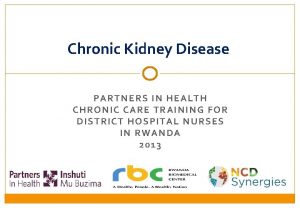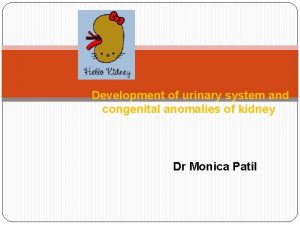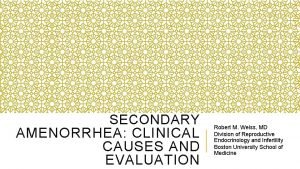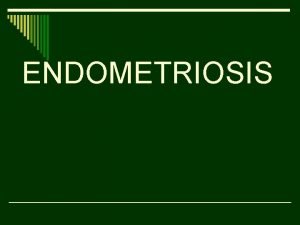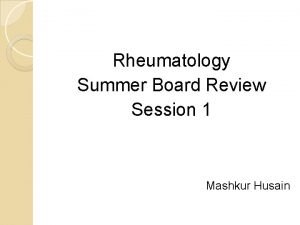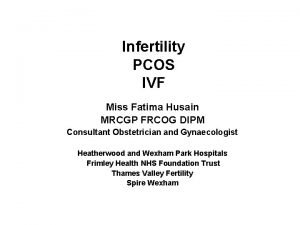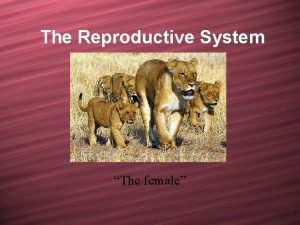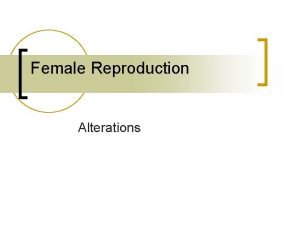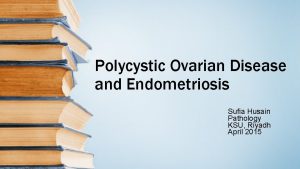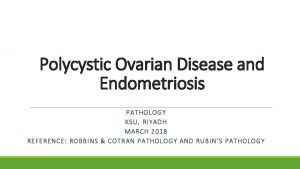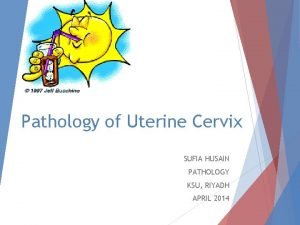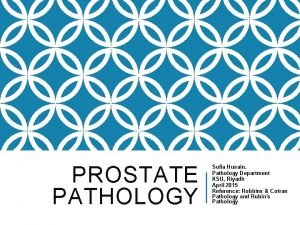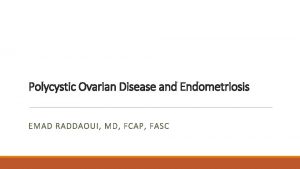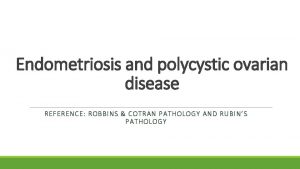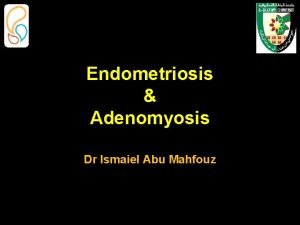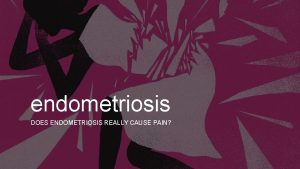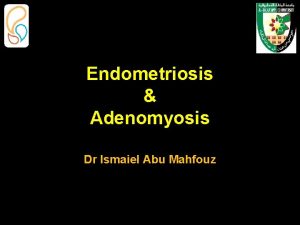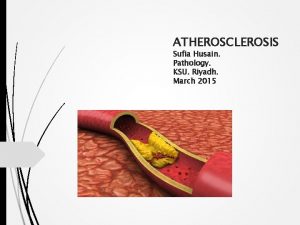Polycystic Ovarian Disease and Endometriosis SUFIA HUSAIN PATHOLOGY

















- Slides: 17

Polycystic Ovarian Disease and Endometriosis SUFIA HUSAIN PATHOLOGY KSU, RIYADH MARCH 2018 REFERENCE: ROBBINS & COTRAN PATHOLOGY AND RUBIN’S PATHOLOGY

Lecture outline: Endometriosis and polycystic ovarian disease. At the end of this lecture, the student should be able to: A] Know the clinicopathologic features of endometriosis with special emphasis on: definition, typical sites and theories behind its pathogenesis. B] Understand the clinical manifestations and pathologic features of polycystic ovarian disease.

Polycystic Ovarian Disease (PCOD) Polycystic ovaries are characterized by bilateral enlargement of ovaries by multiple small cysts, chronic anovulation and clinical manifestations secondary to excessive production of estrogens androgens, mainly androgens. The initial abnormality resulting in the syndrome is not known but is believed to be related to hypothalamus-pituitary dysfunction leading to oversecretion of luteinizing hormone (LH). LH in turn stimulates the ovary to produce excess androgens. While the secretion of follicle stimulating hormone (FSH) is inhibited leads to suppression of ovulation and formation of cystic follicles in the ovary. Patients have: • high levels of LH, • low FSH, • high testosterone and • high estrogen. Other names for this syndrome include polycystic ovarian syndrome and Stein-Leventhal syndrome http: //www. sustainhealth. com. au/wp-content/uploads/2015/02/polycystic-ovarian-syndrome. jpg

Polycystic Ovarian Disease Clinical appearances. Usually young women (between 15 and 30 years), present with: - secondary amenorrhea with anovulation - oligomenorrhea or irregular menses - infertility - hirsutism - virilism due to increased androgenic (masculinizing) hormones - obesity - acne

Polycystic ovarian disease. A: The ovarian surface reveals numerous nodular elevations of clear cysts. B: Cut section shows several subcortical cystic follicles in the ovary. C: Cystic follicles seen in a lowpower microphotograph. Picture Taken from Robbins and Cotran Pathologic basis of disease. 8 th edition, Chapter 21, 2010 Sanders http: //cdns. medindia. net/images/patientinfo/300 x 250/polycystic-ovarian-syndrome. jpg

Histology Polycystic Ovarian Disease Ovaries: ◦ Ovaries are 2 times the normal size with many subcortical cysts measuring 0. 5 to 1. 5 cm in diameter. ◦ Microscopically, the outer portion of the cortex is thickened and fibrotic (cortical stromal fibrosis) with multiple cysts underneath. The follicular cysts usually have a prominent theca interna layer. ◦ Corpora lutea are frequently absent (because no ovulation, women with PCOD have anovulatory cycles). Endometrium: ◦ The chronic anovulation unopposed estrogen leads to a hyper estrogenic state endometrium may develop estrogen associated hyperplasia and show any of the following: Ø simple with or without atypia Ø complex hyperplasia, with or without atypia Ø or even endometrial adenocarcinoma

Polycystic Ovarian Disease Women with PCOD are at risk for the following: Endometrial hyperplasia and endometrial cancer Insulin resistance/Type II diabetes High blood pressure Depression/Anxiety Dyslipidemia Cardiovascular disease Strokes Weight gain Miscarriage Acanthosis nigricans (patches of darkened skin under the arms, in the groin area, on the back of the neck) Autoimmune thyroiditis

Treatment with drugs that either induce ovulation (clomiphene or h. CG) or regulate the menstrual cycle restores fertility. Reduction of ovarian volume by wedge resection of the ovaries is also successful in initiating ovulation and restoring fertility. The endometrial changes usually regress once ovulation is achieved.


Endometriosis Normally endometrial glands and endometrial stroma are found in the endometrium of the uterus. Endometriosis is the presence of ectopic endometrial glands and stroma outside the uterus. Endometriosis is usually found on the peritoneal surfaces of the reproductive organs and adjacent pelvic organs. The most frequent location is the Ø ovary (approx. 50%) Ø followed by the pouch of Douglas and uterine ligaments. Ø Occasionally: in cervix, vagina, perineum, bladder, large bowel and umbilicus Ø Rarely: in small bowel, kidneys, lungs, nose and brain. It has been reported in men. The sites involved have been the bladder, scrotum and prostate It is non-neoplastic. Like the uterine endometrium it is responsive to the hormonal variations of the menstrual cycle, and bleeds during menstruation. Therefore in endometriosis there is menstrual type bleeding at the site of the ectopic endometrium, resulting in blood filled areas (e. g. chocolate cysts). http: //upload. wikimedia. org/wikipedia/commons/d/d 5/Blausen_0349_Endometriosis. png

Endometriosis : Clinical features depends on the site of endometriosis. Dysmenorrhea, cyclic abdominal pain and dyspareunia are common symptoms. Usually there is severe menstrual-related pain. Often results in infertility. Endometriosis usually appears as multiple red or brown (due to hemosiderin) 1 mm to 5 mm nodules (some may form larger masses or cysts). Dense fibrous adhesions may surround the foci. http: //www. coastalivf. com. au/images/endometriosis. jpg

Endometriosis Repeated hemorrhage into the ovary with each menstrual cycle produces cysts, filled with chocolate-brown material. The cyst is called "chocolate cyst”. With time the ovaries become totally cystic and turn into large cystic masses filled with chocolate brown fluid. Clinical behavior Benign with no malignant potential. May recur after surgical excision but the risk is low. Chocolate cyst of ovary (endometriotic cyst)

Endometriosis, complications Infertility Adhesions http: //longstoryshortgirl. com/wp-content/uploads/2014/08/causes-of-endometriosis-cyst. jpg

Endometriosis histology Ectopic endometrial glands and endometrial stroma are present. Denatured blood from previous bleeding is present. Macrophages containing hemosiderin (siderophages) are present. When endometriosis develops in a muscular organ, the smooth muscle around it is often hyperplastic. "Uterine adenomyosis (1)". Licensed under CC BY-SA 3. 0 via Wikimedia Commons - http: //commons. wikimedia. org/wiki/File: Uterine_adenomyosis_(1). JPG#/media/File: Uterine_adenomyosis_(1). JPG Massive abdominal wall endometriosis masquerading as desmoid tumour Anand Mani, Deshmukh Sanjay D Year : 2011 | Volume: 4 | Issue Number: 2 | Page: 141 -14 http: //www. jcasonline. com/articles/2011/4/2/images/JCutan. Aesthet. Surg_2011_4_2_141_85043_u 4. jpg

Adenomyosis This is defined as the presence of endometrial glands and endometrial stroma in the myometrium of the uterus. It is more common in the posterior wall than the anterior wall (but it may affect both walls in the same uterus). The disease is primarily a disorder of parous women and is uncommon in the nullipara. It is associated with menorrhagia and severe dysmenorrhea. In 1/3 rd of the patients: there are no symptoms. When extensive the lesions cause myometrial thickening with small yellow or brown cystic spaces containing fluid or blood. Clinical behavior. This is a benign condition with no known malignant potential that regresses after the menopause

Adenomyosis CROSS SECTION THROUGH THE WALL OF A HYSTERECTOMY SPECIMEN OF A 30 -YEAR-OLD WOMAN WHO REPORTED CHRONIC PELVIC PAIN AND ABNORMAL UTERINE BLEEDING. THE ENDOMETRIAL SURFACE IS AT THE TOP OF THE IMAGE, AND THE SEROSA IS AT THE BOTTOM http: //www. paroleauxjeunes. fr/wp-content/uploads/2013/11/adenomyose. jpg "Adenomyosis, Hysterectomy Specimen" by Ed Uthman, MD - http: //www. flickr. com/photos/euthman/64025/. Licensed under CC BY-SA 2. 0 via Wikimedia Commons - http: //commons. wikimedia. org/wiki/File: Adenomyosis, _Hysterectomy_Specimen. jpg#/media/File: Adenomyosis, _Hysterectomy_Spe cimen. jpg

Lecture outline: Endometriosis and polycystic ovarian disease. At the end of this lecture, the student should be able to: A] Know the clinicopathologic features of endometriosis with special emphasis on: definition, typical sites and theories behind its pathogenesis. B] Understand the clinical manifestations and pathologic features of polycystic ovarian disease.
 Symptomatic polycystic kidney disease
Symptomatic polycystic kidney disease Infantile polycystic kidney
Infantile polycystic kidney Types of endometriosis
Types of endometriosis Causes of secondary amenorrhea
Causes of secondary amenorrhea Endometriosis
Endometriosis Suatu keadaan telah dikatakan sebagai endometriosis jika
Suatu keadaan telah dikatakan sebagai endometriosis jika Waris hussain
Waris hussain Ashraf husain
Ashraf husain Ashraf husain
Ashraf husain Mashkur husain md
Mashkur husain md Miss fatima husain
Miss fatima husain Crohn's disease pathology outlines
Crohn's disease pathology outlines Bharathi viswanathan
Bharathi viswanathan Ovaries functions
Ovaries functions Female reproductive system external
Female reproductive system external Ca 125
Ca 125 Ovarian cyst about to rupture
Ovarian cyst about to rupture Labeled female reproductive system
Labeled female reproductive system
